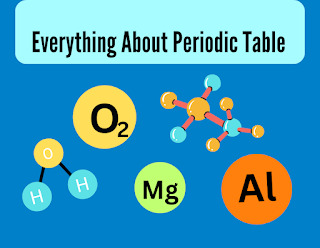Know Everything About Periodic Table
The periodic table is one of the most iconic and recognizable tools in all of science. It is a visual representation of the elements and a way to organize, categorize them based on their unique properties. But what is the history behind this remarkable chart, and why is it so important to our understanding of the world around us?
 |
| History and everything about periodic table |
The origins of the periodic table traced back to the late 18th century, when chemists began to realize that certain elements had similar properties. In 1789, Antoine Lavoisier published his "Table of Simple Substances," which listed all of the known elements at the time. That table was not organized in any particular way, but it was an important step in the development of the periodic table.
Over the next few decades, more and more elements were discovered then chemists continued to look for patterns in their properties. In 1817, Johann Dobereiner noticed that certain groups of elements had similar properties and he created what he called "triads" of elements. For example he grouped lithium, sodium and potassium together because they all had similar reactivity and formed salts with similar properties.
Dobereiner's triads were an important step forward but they were limited at their scope. There were only a few triads that he could identify and many elements did not fit into any of them. But his work inspired others to look for similar patterns and soon other chemists were making their own contributions to this field.
One of the most important figures in the development of the periodic table was Dmitri Mendeleev. In 1869 Mendeleev published a table of elements that organized them in a way similar to the modern periodic table. He arranged the elements in order of increasing atomic mass and he noticed that certain groups of elements had similar properties.
But Mendeleev did more than just organize the elements by their properties. He also predicted the properties of some elements that had not yet been discovered. For example, he predicted the existence of an element he called "eka-aluminum" which he believed would have properties similar to aluminum but would be lighter. This element was later discovered and given the name "gallium."
Mendeleev's periodic table was not perfect. Some of his predictions were incorrect and he had to leave gaps for elements that had not yet been discovered. But his work was a major step forward. It laid the foundation for the modern periodic table.
Over the years, the periodic table has continued to evolve. Today it is organized by atomic number rather than atomic mass, and elements are arranged in periods and groups based on their electron configurations. This organization allows us to understand the relationships between the elements in a more fundamental way.
Periodic table is not just a tool for scientists, it is also a symbol of the power of human curiosity and ingenuity. It represents the efforts of generations of scientists who have worked to understand the world around us. And it reminds us that there is still so much left to discover. As new elements are synthesized in laboratories around the world, periodic table continues to grow and evolve, an evidence to the human spirit of exploration and discovery.
 |
| Elements of periodic table |
In conclusion, the periodic table is one of the most important tools in all of science. It allows us to understand the fundamental properties of the elements and reminds it us the power of human curiosity and ingenuity. From the triads of Dobereiner to the predictions of Mendeleev, the periodic table has been shaped by the work of countless scientists over the years. And as we continue to explore the universe around us, it will continue to evolve and expand, a symbol of our never-ending quest for knowledge and understanding.





0 Comments